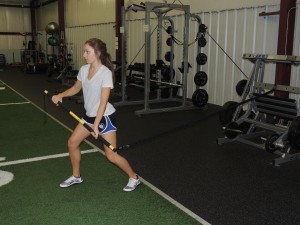 Since strength and power emanate “from the inside out,” improving core strength and stability is important to athletic performance.
Since strength and power emanate “from the inside out,” improving core strength and stability is important to athletic performance.
Most sports require rotational movement (swinging a bat or hockey stick, throwing a baseball or football, etc.), so the development of rotational strength and power is an important consideration when training the core. Rotational exercises – e.g., medicine ball twists and lateral throws, kettlebell swings, and other “twisting” exercises – are training program components of virtually every athlete with whom we work.
Anti-rotational exercises require athletes to resist rotation when executing a specific movement while the application of an external force attempts to push or pull them laterally (rotationally). Anti-rotational exercises are important because, in many sports – especially contact sports (football, basketball, soccer, and hockey come to mind) – it’s necessary for athletes to be able to maintain directional movement while resisting opponents’ contact forces that have the potential to “knock them off course.”
At our facility, we use the TRX Rip Trainer for most of our anti-rotational training. It has a safe and simple design, and is very user-friendly and versatile. However, there are other exercise equipment options, and you can even make your own.
We incorporate a different anti-rotational exercise into every athlete’s training program, each week. Typically, we have our athletes perform 1 or 2 sets of 10 repetitions, from each side.
Here are a few sample exercises, with instruction and demonstration:
Anti-Rotational Straight Arm Squat
Standing farther from the anchor point increases the resistance and, subsequently, difficulty of the exercise. Moving the anchor point higher or lower helps the trainer target different areas of the core, and can also simulate a more “sport-specific” exercise (e.g., lower anchor point for hockey; middle anchor point for baseball; and variable anchor point for lacrosse).
Exercise selection can be varied, as many exercises can be performed with the addition of lateral resistance (there are also lots of TRX Rip Trainer exercises you can find on their website and elsewhere, online). Other examples are the standing row, military press, and straight-arm lunge; as well as “swinging” and “chopping” exercises.
Your thoughts?
WE BUILD STRONGER ATHLETES!
We provide motivated athletes with a simple, customized training plan to help them improve performance and reduce injury risk.
![espnw_g_diggins01jr_200[1]](https://athleticperformancetc.files.wordpress.com/2012/08/espnw_g_diggins01jr_2001.jpg?w=200&h=300)